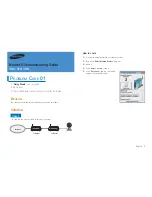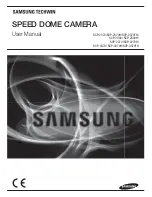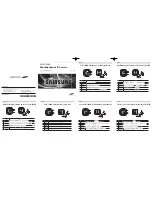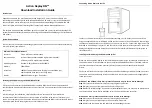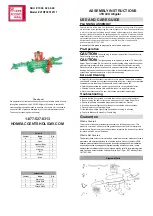
8
E
- Connect the equipment into an outlet on a different circuit (not the circuit to
which the receiver is connected).
- Consult the dealer or an experienced radio/TV technician for help.
Canada, Industry Canada (IC) Notices
This Device complies with Industry Canada License-exempt RSS standard(s).
Operation is subject to the following two conditions: 1) this device may not
cause interference, and 2) this device must accept any interference, including
interference that may cause undesired operation of the device.
Under Industry Canada regulations, this radio transmitter may only operate
using an antenna of a type and maximum (or lesser) gain approved for the
transmitter by Industry Canada. To reduce potential radio interference to other
users, the antenna type and its gain should be so chosen that the equivalent
isotropically radiated power (e.i.r.p.) is not more than that necessary for
successful communication.
Battery Safety
WARNING:
Batteries can explode, or leak, and can cause injury or fire.
To
reduce this risk:
• Carefully follow all instructions and warnings on the battery label and
package.
• Always insert batteries correctly with regard to polarity (+ and –), as marked
on the battery and the equipment.
• Do not short battery terminals.
• Do not charge disposable batteries.
• Do not mix old and new batteries. Replace all batteries at the same time
with new batteries of the same brand and type.
• Remove dead batteries immediately and dispose of per local codes.
• Do not dispose of batteries in fire.
• Keep batteries out of reach of children.
Installing AAA Batteries
Load two new AAA batteries in the CMHT77623 stud sensor.
1.
On the bottom of the stud sensor, lift up the latch (Figure
B
1
) to unlock
the battery compartment cover.
2.
Move the cover upward (Figure
B
2
) and remove it once it separates
from the stud sensor.
3.
Insert two new, high-quality AAA batteries, making sure to position the
- and + ends of each battery as noted inside the battery compartment
(Figure
B
3
).
4.
Place the cover back on the stud sensor (Figure
B
4
).
• Insert the two pins at the top of the cover into the holes near the top of
the battery compartment.
• Slowly lower the cover and press down until the latch locks securely on
the stud sensor.
5.
Press
or
to test the stud sensor.
• The stud sensor should sound one short beep. The Power LED should
turn on. All the other LEDs should illuminate for a second and then turn
off.
• Whenever you press
or
, the green Power LED should
illuminate to indicate that the batteries are good. If this LED blinks or
does not illuminate, change the batteries.
Using the Stud Sensor
The CMHT77623 stud sensor will help you find wood or metal studs, AC voltage,
or metal objects (e.g., pipe) behind drywall.
• The stud sensor has two buttons. Use the bottom button (Figure
A
3
) to
search for wood/metal studs or AC, and use the top button (Figure
A
2
) to
search for metal objects (e.g., pipe).
• The stud sensor will detect wood studs through up to 1” (25mm) thick
drywall, and metal studs and AC voltage through up to 1.5” (38mm) thick
drywall.
• The stud sensor will detect a ferrous metal object (contains iron) up to 3”
(76.2mm) from the surface of the wall to the center of the object.
• The stud sensor will detect a non-ferrous metal object (e.g., copper) up to 2”
(51mm) from the surface of the wall to the center of the object.
• When AC voltage is found, the stud sensor will sound short (alternating)
beeps and light the AC LED (Figure
A
5
).
• When the center of a stud is found (or a metal object is nearby), the stud
sensor will sound one longer (constant) beep and light the center LEDs
(Figure
A
4
).
• When live AC and the center of a stud are both found, the stud sensor will
alternate between the long and short beeps, and light the center LEDs and
the AC LED.
Finding a Stud
1.
To hold the stud sensor, place your thumb on one side of the stud sensor,
your pointer finger and your palm over the center of the stud sensor, and
the rest of your fingers on the same hand on the other side of the stud
sensor (Figure
C
1
).
2.
Gently place the stud sensor flat against the wall and parallel to a door or
window on the same wall, which gives you an indication of how the studs
are positioned behind the wall (Figure
C
2
).
3.
Without moving the stud sensor, use your pointer finger to press and hold
(Figure
A
3
). WAIT 1 sec until all the LEDs (except the Power
LED) turn off.
4.
While still pressing
,
SLOWLY
move the stud sensor to the left or the
right on the wall.
5.
As you move the stud sensor, watch the stud sensor LEDs and listen for
beeps.
• If
lights on the right side of the stud sensor (Figure
D
1
),
continue moving the stud sensor to the right to find the nearest stud. As
you get closer to the stud,
will light (Figure
D
2
).
• If
lights on the left side of the stud sensor, continue moving the
stud sensor to the left to find the nearest stud. As you get closer to the
stud,
will light.
• If live AC voltage is found within 2”-18” (.05m - .5m) of the stud
sensor’s current position, the AC LED will illuminate. If the date code
on your stud sensor is
2020 09-XX or earlier
, you will also hear short
beeps. (For ease of use, the short beeps were removed from stud sensors
dated
2020 10-XX or later
.)
NOTE: Static electrical charges that can develop on drywall and other
surfaces will spread the voltage detection area many inches on each
side of the actual electrical wire. This can cause the stud sensor
to indicate that it has found live AC when it is not actually near an
electrical wire (Figure
E
1
). To aid in locating the wire position, place
your other hand on the surface approximately 12” (30cm) from the stud
sensor (Figure
E
2
), or hold the stud sensor ½” - 2” (13mm - 50mm)
away from the wall surface.
Содержание CMHT77623
Страница 2: ...A 1 3 2 4 5 6 Figures 2 ...
Страница 3: ...C B 1 2 3 ...
Страница 4: ...D Figures 4 ...
Страница 5: ...E 1 2 5 2 18 12 AC 2020 09 XX AC 2020 09 XX ...
Страница 6: ...F Figures 6 ...
Страница 21: ...Notes ...
























